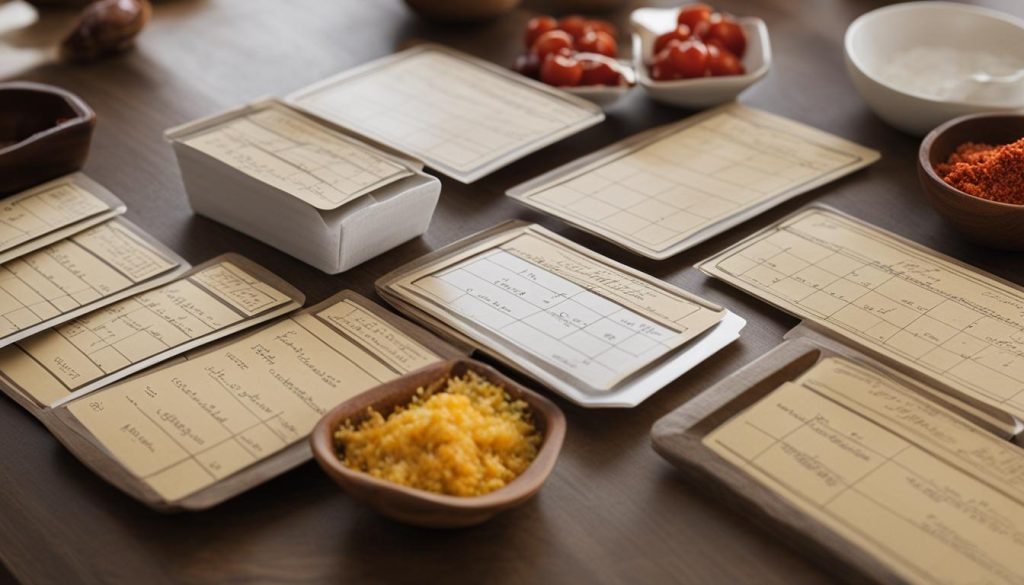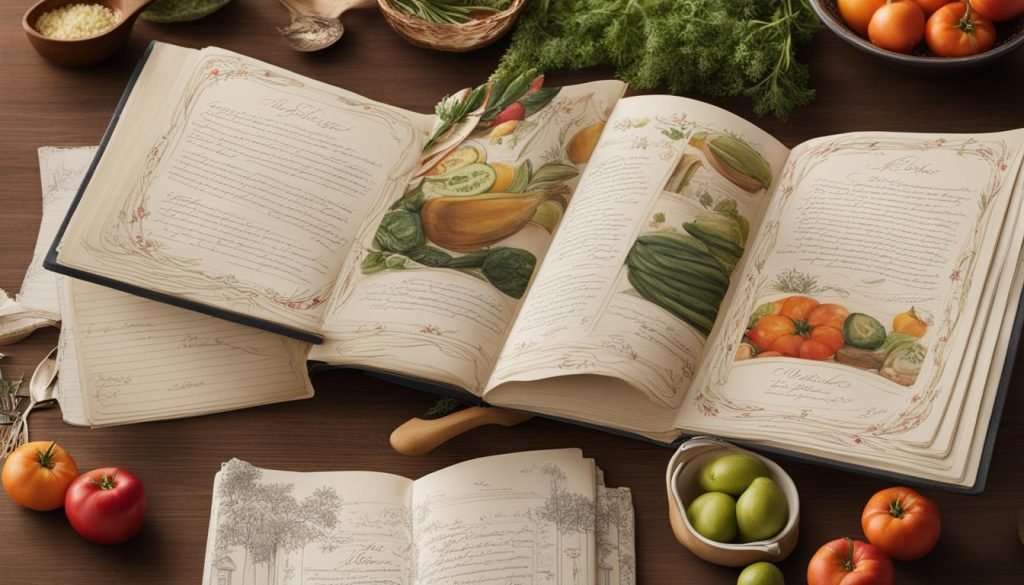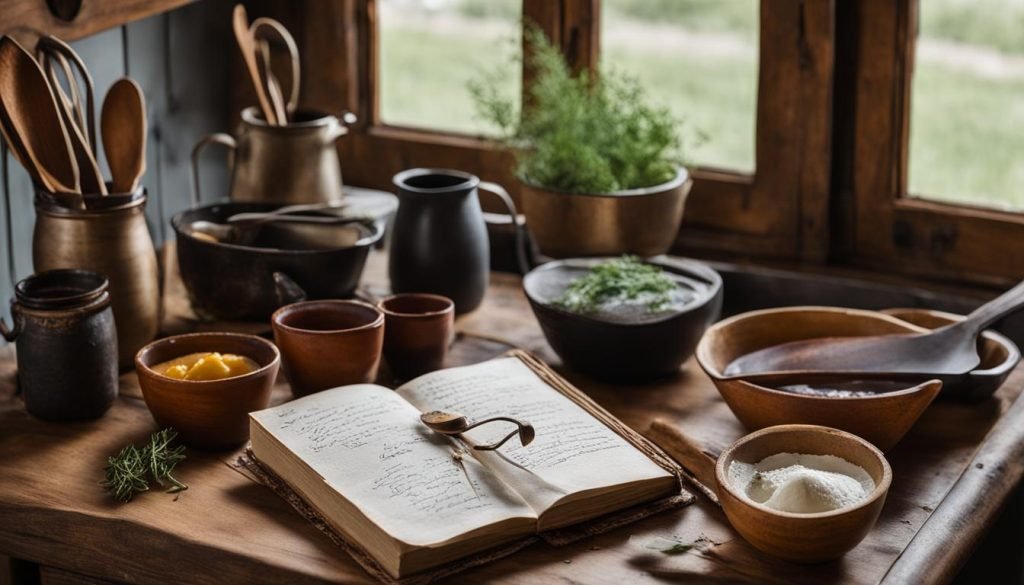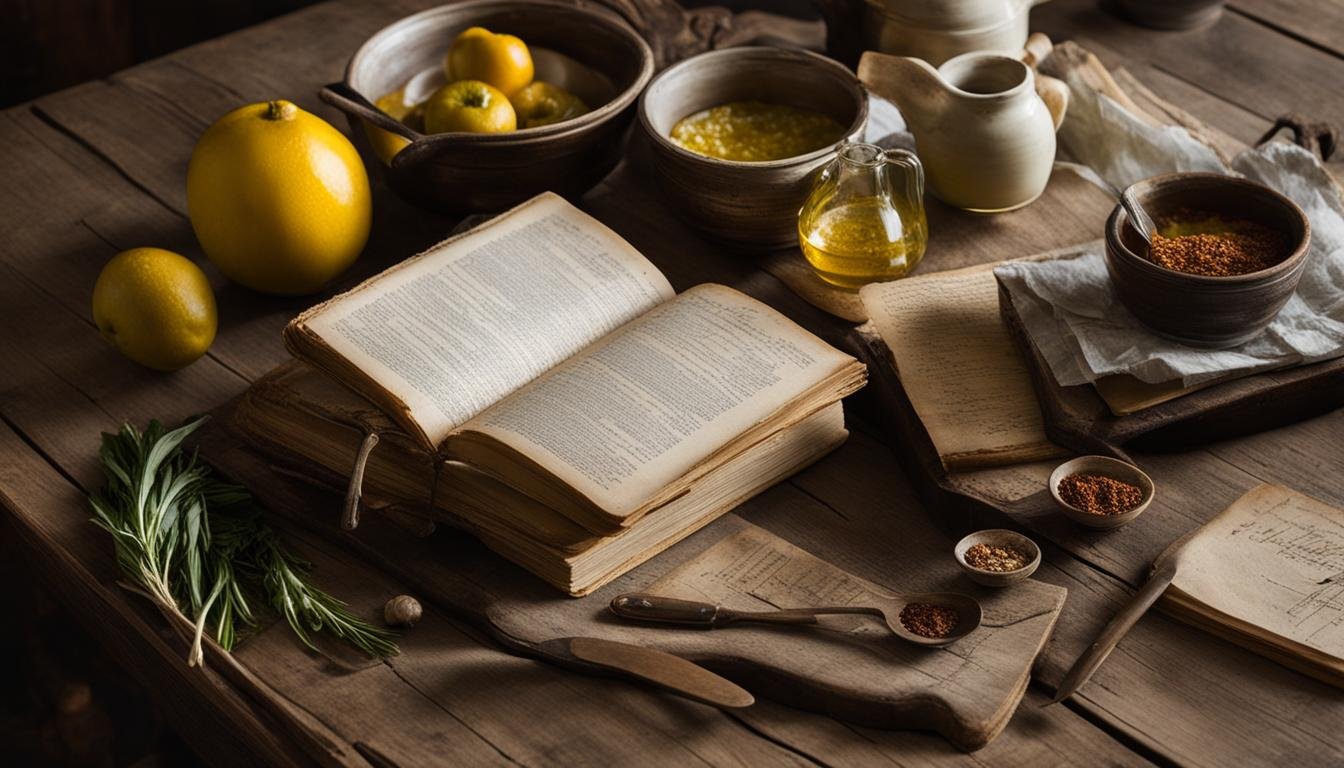Handwritten Recipe Books: Uncover the Secret Stories Behind Your Family’s Favorite Dishes!
Handwritten recipe books are a meaningful way to preserve your family’s culinary traditions and create a lasting heirloom. By documenting and organizing your cherished family recipes, you can pass down the magic of your ancestors’ cooking to future generations. In this article, we will guide you through the process of creating your own handwritten recipe book, from choosing a theme to gathering and preserving recipes. Let’s dive in!
Key Takeaways:
- Handwritten recipe books are a special way to preserve your family’s culinary traditions.
- Organizing and documenting your family recipes creates a lasting heirloom.
- Creating a handwritten recipe book allows you to pass down the magic of your ancestors’ cooking.
- Choose a theme for your book to guide the project and tell a part of your family’s story.
- Gathering and preserving family recipes is the heart of any handwritten recipe book.
The Versatility of Handwritten Recipe Books
One of the great things about handwritten recipe books is their versatility. You have the freedom to choose what goes into your book, how long it will be, and what it will look like. You can create vintage-inspired recipe books with a classic feel, or opt for more modern-style recipe notebooks. Additionally, recipe organizers are a great way to keep your recipes neat and organized. The possibilities are endless, so let your creativity guide you in shaping the perfect book for your family’s recipes.
When it comes to vintage recipe books, you can evoke a sense of nostalgia by using vintage-inspired paper, fonts, and illustrations. Consider including the stories behind the recipes, handwritten notes, and even old family photos to add a personal touch. Recipe notebooks, on the other hand, offer a more contemporary and minimalist approach. With clean lines, simple layouts, and modern fonts, these notebooks are perfect for those who prefer a sleek and streamlined aesthetic.
“A handwritten recipe book is not only a keepsake, it’s a work of art that reflects your family’s culinary heritage.” – Emily Thompson
Recipe organizers, such as binders or digital platforms, provide an efficient way to categorize and store your recipes. By organizing your recipes into sections, such as appetizers, main courses, and desserts, you can easily locate your favorite dishes whenever you need them. These organizers also offer features like index pages, dividers, and pockets, making it even easier to keep your recipes tidy and accessible.
The Benefits of Handwritten Recipe Books
While digital platforms and online recipe collections have become popular, there’s something special about holding a handwritten recipe book in your hands. It’s a tangible connection to the past, a piece of family history that can be passed down from generation to generation. Handwriting adds a personal touch and creates a sense of authenticity that can’t be replicated by digital printouts.
Furthermore, handwritten recipe books allow for creativity and flexibility. You can decorate the pages with illustrations, notes, and memories that accompany each recipe. The act of writing down recipes also helps to reinforce your culinary skills and create a deeper bond with the dishes you love. Whether you’re an experienced cook or just starting your culinary journey, a handwritten recipe book can become a treasured companion in the kitchen.
| Benefits of Handwritten Recipe Books | Benefits of Digital Recipe Collections |
|---|---|
|
|
Choosing a Theme for Your Handwritten Recipe Book
When creating your handwritten recipe book, it’s important to choose a theme that will guide the overall direction and focus of your project. A theme helps to tell a story and adds a personal touch to your book. Consider the following themes:
- Family Tradition: Include recipes from various generations of your family, showcasing the dishes that have been passed down through the years. This theme celebrates the culinary heritage of your family and creates a sense of connection to your ancestors.
- Culinary Heritage: Focus on a particular cuisine or cultural background that holds significance to your family. This theme allows you to delve into the unique flavors and traditions associated with your culinary heritage.
By centering your handwritten recipe book around a theme, you create a cohesive and meaningful collection of recipes that reflect your family’s culinary identity. It also makes the book more engaging and enjoyable for those who read and use it. Choose a theme that resonates with you and your family, and let it guide you in curating a cookbook that will be treasured for generations.
| Theme | Description |
|---|---|
| Family Tradition | Include recipes from various generations of your family, showcasing the dishes that have been passed down through the years. |
| Culinary Heritage | Focus on a particular cuisine or cultural background that holds significance to your family, exploring the unique flavors and traditions associated with it. |
By centering your handwritten recipe book around a theme, you create a cohesive and meaningful collection of recipes that reflect your family’s culinary identity. It also makes the book more engaging and enjoyable for those who read and use it. Choose a theme that resonates with you and your family, and let it guide you in curating a cookbook that will be treasured for generations.
Gathering and Preserving Family Recipes
The heart and soul of your handwritten recipe book lies in the collection and preservation of your family’s cherished recipes. These recipes are more than just a list of ingredients and instructions; they are a piece of your family’s history and a connection to your culinary heritage.
To begin, gather the recipes you already have in your possession. This could include handwritten recipes passed down through generations or printed recipes that hold sentimental value. If you have old handwritten recipes, consider scanning them to preserve their original look.
Next, reach out to other family members and ask them to contribute their favorite recipes. Encourage them to share any additional information or memories associated with the recipes. This can add a personal touch and make your recipe book even more meaningful.
Set deadlines and create a system to effectively gather all the recipes. This will ensure that you have a diverse collection of dishes to include in your book. Whether it’s a treasured family recipe for grandma’s apple pie or a secret sauce passed down from generation to generation, every recipe has a story to tell.
Preserving Handwritten Recipes
Preserving the authenticity of handwritten recipes is an essential part of creating a true culinary heirloom. While scanning the recipes is one option, you may also consider using protective sleeves to keep the original handwritten recipes intact. These sleeves will not only protect the recipes from wear and tear but also allow you to easily flip through and read them.
Another way to preserve handwritten recipes is by transcribing them into a digital format. This can be done by typing them out or using a scanning app that recognizes handwriting. Once digitized, you can print and bind the recipes into your handwritten recipe book or include them alongside the original handwritten versions.
Organizing Your Collection
When it comes to organizing your collection of family recipes, there are several approaches you can take. One option is to group them by meal category, such as appetizers, main courses, desserts, and so on. Another option is to organize them by the person who contributed the recipe. You can create sections for recipes from grandparents, parents, aunts, and uncles, or any other family members who have shared their culinary creations.
Consider creating a table of contents or index page to make it easier to navigate through your recipe book. This will allow you and future generations to quickly find the recipes they’re looking for. You can also include dividers or tabs to separate different sections of your book, making it even more user-friendly.
Capturing Memories and Stories
Don’t forget to capture the memories and stories that accompany each recipe. These anecdotes add depth and personality to your handwritten recipe book, allowing readers to connect with the dishes and the people behind them. This can be done by including a brief description or background information for each recipe, sharing the significance it holds in your family’s history.
Additionally, you can create a section at the beginning of your recipe book to introduce your family’s culinary traditions and share your own memories and experiences. This serves as a beautiful introduction to your collection and sets the tone for the journey that awaits the readers as they explore the recipes within.
The Uniform Format for Your Recipes

To ensure consistency and clarity in your handwritten recipe book, it’s important to have a uniform format for each recipe. By standardizing the measurements and directions, you make it easier for future generations to follow the recipes and recreate the dishes with the same delicious results.
When it comes to measurements, convert any old or non-standard units to more commonly used ones. For example, if a recipe calls for ounces, consider including the equivalent in grams or tablespoons. This way, anyone can easily understand and follow the measurements, regardless of their familiarity with specific units.
Additionally, when writing the recipe directions, be clear and concise. Use step-by-step instructions that are easy to follow. Break down the process into simple, manageable tasks. Consider using bullet points or numbered lists to make the directions visually organized and user-friendly.
Remember, the goal is to create a recipe book that is not only a beautiful keepsake but also a practical resource for anyone who wishes to recreate the dishes. By creating a uniform format for your recipes, you ensure that the recipes are accessible and easy to use for generations to come.
Benefits of a Uniform Format:
- Consistency: Having a uniform format makes it easier to read and follow the recipes consistently.
- Accessibility: By converting measurements and using clear directions, you make the recipes accessible to a wider audience.
- Reproducibility: Future generations will be able to recreate the dishes with the same delicious results.
- Organization: A uniform format ensures that your handwritten recipe book is organized and easy to navigate.
By taking the time to create a uniform format for your recipes, you ensure that your handwritten recipe book becomes a valuable resource for your family’s culinary traditions.
Choosing the Format for Your Handwritten Recipe Book

Once you have gathered and standardized your recipes, it’s time to choose the format for your handwritten recipe book. There are several options available, each with its own unique advantages. Consider your preferences, budget, and the overall aesthetic you want to achieve.
A Classic Cookbook
If you want to create a timeless treasure, a classic cookbook format may be the perfect choice. This format allows you to include stories, anecdotes, and family photos alongside your recipes. It provides a comprehensive and nostalgic experience for readers, immersing them in your family’s culinary journey. A classic cookbook is a wonderful way to preserve your family’s traditions and create a beautifully curated culinary keepsake.
A Recipe Binder
If you prefer a more flexible and customizable approach, a recipe binder is a great option. This format allows you to organize your recipes in a practical and functional way. With a recipe binder, you can easily add, remove, or rearrange pages as needed. It provides the convenience of easy recipe access and allows you to expand your collection over time. A recipe binder is a versatile choice for those who value practicality and flexibility.
A Digital Photo Book
For those who prefer a modern and digital approach, creating a digital photo book is a fantastic option. Online services like Snapfish or Shutterfly offer easy-to-use templates and designs that allow you to showcase your recipes in a visually stunning way. A digital photo book can include high-resolution images of your finished dishes, making it a feast for the eyes. This format is especially great for sharing your recipes with family members who may be far away or for easy access on digital devices.
Working with a Self-Publisher
If you plan on creating a large number of books or desire a professional finish, working with a self-publishing platform like HeritageCookbook.com is an excellent choice. These platforms provide professional printing and binding services, ensuring your handwritten recipe book looks and feels like a published cookbook. With a self-publisher, you can bring your vision to life with high-quality materials and finishes, creating a truly polished masterpiece.
| Format | Advantages |
|---|---|
| Classic Cookbook | Timeless and nostalgic |
| Recipe Binder | Flexible and customizable |
| Digital Photo Book | Modern and visually stunning |
| Working with a Self-Publisher | Professional finish and high-quality materials |
Personalizing Your Handwritten Recipe Book

Make your handwritten recipe book truly unique by adding personal touches and elements that reflect your family’s culinary traditions. Here are some ideas to help you personalize your book:
Table of Contents
A table of contents or index can make it easier for readers to navigate your recipe book. Divide your book into chapters or sections based on different types of recipes or meal categories. This will help organize the content and make it easier to find specific recipes.
Heartfelt Introduction
Write a heartfelt introduction to set the tone for your recipe book. Share your own connection to the recipes and the memories they evoke. This will give your book a personal touch and make it even more meaningful to future generations.
Blank Pages or Room for Notes
Include blank pages or leave room for notes throughout your recipe book. This allows future generations to add their own favorite recipes and memories. It creates a space for them to continue the tradition and make the book their own.
By personalizing your handwritten recipe book with a table of contents, a heartfelt introduction, and blank pages, you are creating a truly special heirloom that captures the essence of your family’s culinary heritage. It’s a book that will be cherished for generations to come.
Designing a Functional Handwritten Recipe Book

When creating your handwritten recipe book, it’s important to consider its functionality in the kitchen. After all, you want your book to be a practical tool that you can easily reference while cooking. Here are a few tips to ensure that your book is kitchen-friendly and designed for easy reference.
Choose a Format That Lies Flat
One of the key features of a functional handwritten recipe book is a format that lies flat on the kitchen counter. This allows you to keep the book open to the desired page while you work on the recipe. Consider using a spiral-bound notebook or a binder with a lay-flat design. This way, you won’t have to worry about pages constantly flipping or holding the book open with one hand while trying to follow the recipe with the other.
Create Clear and Readable Fonts
Another important aspect of a functional recipe book is the choice of fonts. Opt for clear and easy-to-read fonts that are legible at a glance. Avoid overly cursive or decorative fonts that may be difficult to decipher. Remember, you want your recipes to be easily followed, so choose fonts that prioritize clarity over style.
Add Tabs or Dividers for Easy Navigation
To further enhance the functionality of your handwritten recipe book, consider adding tabs or dividers. These can help you quickly locate specific recipes or sections of your book. For example, you can create tabs for different meal categories like appetizers, main courses, and desserts. This way, you can effortlessly flip to the desired section without wasting time searching through the entire book.
By designing a functional handwritten recipe book, you’ll have a reliable kitchen companion that makes cooking a breeze. With a format that lies flat, clear and readable fonts, and tabs for easy navigation, you’ll be able to follow your cherished family recipes with ease and create delicious meals that honor your culinary traditions.
Celebrating Your Handwritten Recipe Book
Now that your handwritten recipe book is complete, it’s time to celebrate all the hard work and love you put into preserving your family’s culinary history. Hosting a family dinner party or a book launch event can be a wonderful way to share the culmination of your efforts with your loved ones. It’s a time to gather together, savor delicious meals, and reflect on the memories and traditions that make your family unique.
During the family dinner party or book launch, take the opportunity to showcase your handwritten recipe book and share the stories behind the recipes. Display the book prominently on a table, inviting guests to browse through the pages and discover the culinary treasures inside. Encourage your guests to try some of the recipes that hold special meaning to your family, creating a chance for everyone to come together and enjoy the delicious dishes that have been passed down through generations.
“Food is the ingredient that binds us together.”
While enjoying the food and celebrating your handwritten recipe book, take the time to savor the family history that comes alive through each recipe. Listen to the stories shared by older family members who remember the loved ones who originally created these dishes. Embrace the shared experience of cooking and enjoying meals together, knowing that you are carrying on a legacy that will continue to be cherished for years to come.
Your handwritten recipe book is not just a collection of recipes, but a testament to the love, memories, and traditions that make your family unique. By creating this culinary keepsake, you have sown the seeds for future generations to continue the legacy of your family’s cooking. So, raise a glass and toast to the joy of preserving your family’s culinary traditions, as you savor the history and love that is captured within the pages of your handwritten recipe book.
Table 1: Celebrating Your Handwritten Recipe Book
| Event | Details |
|---|---|
| Family Dinner Party | A gathering of close family members to celebrate the completion of your handwritten recipe book. |
| Book Launch | An event where friends, family, and other guests can come together to commemorate the creation of your handwritten recipe book. |
| Savoring Family History | Enjoying the shared experience of cooking and relishing the memories and traditions embedded in your family’s recipes. |
Preserving Handwritten Recipes as Heritage Wall Art
Your handwritten recipe book is not only a culinary keepsake but also a piece of heritage. Consider preserving the handwriting of your ancestors as a unique form of heritage wall art. Frame and display their handwritten recipes as a beautiful reminder of the love and legacy they left behind in the kitchen. This creative way of preserving their handwriting allows you to honor their memory while adding a personal touch to your home decor.
By transforming these handwritten recipes into heritage wall art, you bring a piece of your family’s history into your everyday life. The delicate curves of each letter, the smudges and stains that mark years of use, all capture the essence of the hands that lovingly created these dishes. It’s a tangible connection to your family’s past, a visual representation of the traditions and recipes that have been passed down through generations.
Imagine walking into your kitchen and seeing your great-grandmother’s recipe for apple pie, written in her own hand, displayed proudly on the wall. It’s a powerful reminder of the love and care that went into every meal she prepared. It’s a conversation starter, a way to share stories and memories with family and friends. And most importantly, it’s a way to ensure that these cherished recipes are never forgotten.
Preserving handwritten recipes as heritage wall art not only adds a touch of beauty to your home, but it also serves as a constant reminder of the importance of family and tradition. It’s a way to pay homage to those who came before us and to celebrate the culinary heritage that has shaped our lives. So, gather those cherished recipes, honor your ancestors, and create a stunning display of heritage wall art that will be treasured for generations to come.
Table: Steps to Preserve Handwritten Recipes as Heritage Wall Art
| Step | Description |
|---|---|
| 1 | Gather handwritten recipes from your family |
| 2 | Select recipes with sentimental value or family significance |
| 3 | Scan or photograph the handwritten recipes |
| 4 | Print the scanned or photographed recipes on high-quality paper |
| 5 | Choose decorative frames that complement your home decor |
| 6 | Display the framed recipes in a prominent location |
Conclusion
Creating a handwritten cookbook is an incredible journey that allows you to preserve your family’s cherished recipes and culinary memories. Through this heartfelt endeavor, you are not only passing down delicious dishes but also preserving a part of your family’s heritage.
As you gather and organize your family recipes with love and care, remember the joy and connection that food brings to your loved ones. Each handwritten page is a testament to the shared experiences and cherished moments spent together in the kitchen.
Embrace the process and savor the journey of creating your own handwritten cookbook. Whether you choose a classic style, a digital photo book, or a simple recipe binder, know that your efforts will result in a treasured culinary keepsake that will be passed down through the generations. Your handwritten cookbook will be a cherished family heirloom, filled with not only recipes but also the love and memories that make your family unique.
FAQ
What is the benefit of creating a handwritten recipe book?
Handwritten recipe books allow you to preserve your family’s culinary traditions and create a lasting heirloom. They document and organize cherished family recipes, passing down the magic of your ancestors’ cooking to future generations.
Can I choose the style and format of my handwritten recipe book?
Yes, one of the great things about handwritten recipe books is their versatility. You can choose the theme, length, and appearance of your book, whether you prefer a vintage-inspired feel or a more modern-style notebook. Recipe organizers are also available to keep your recipes neat and organized.
How should I gather the recipes for my handwritten recipe book?
Start by gathering the recipes you already have, whether handwritten or printed. Consider scanning old handwritten recipes to preserve their original look. Reach out to other family members for their favorite recipes and any additional information or memories associated with them. Set deadlines and encourage participation to ensure a diverse collection.
How can I ensure consistency in my handwritten recipe book?
Standardize measurements and directions for each recipe to ensure consistency and clarity. Take the time to convert old measurements and format the recipes uniformly. You may also want to include a section on converting non-standard units if necessary.
What format options do I have for my handwritten recipe book?
You can choose a classic cookbook style with stories and photos, create a simple recipe binder, or even make a digital photo book using online services. If you’re making multiple books, consider working with a self-publishing platform for a professional finish.
How can I personalize my handwritten recipe book?
Make your book unique by adding personal touches like a table of contents or index for easy navigation. Divide the book into chapters or sections based on meal categories or types of recipes. Write a heartfelt introduction to set the tone and share your own connection to the recipes. Leave blank pages or room for notes for future generations to add their own favorite recipes and memories.
What should I consider when designing a functional handwritten recipe book?
Ensure your book is functional in the kitchen by choosing a design that can lie flat on the counter for easy reference while cooking. If possible, choose a design that can be propped up to keep the recipe visible while you work. Opt for clear and easy-to-read fonts and layouts to avoid confusion while following the recipes.
How can I celebrate the completion of my handwritten recipe book?
Host a family dinner party or a book launch event to share the culmination of your hard work with loved ones. Enjoy the delicious dishes and cherished memories preserved in your recipe book, savoring your family’s history through food.
Is there a creative way to preserve the handwriting of my ancestors?
Yes, consider framing and displaying their handwritten recipes as unique heritage wall art. This allows you to honor their memory while adding a personal touch to your home decor.
What is the significance of creating a handwritten recipe book?
Handwritten recipe books go beyond being collections of recipes. They represent your family’s culinary history and cherished memories. Creating one allows you to preserve your family’s traditions and pass them down to future generations, keeping your family connected through the shared experience of cooking and enjoying meals together.




